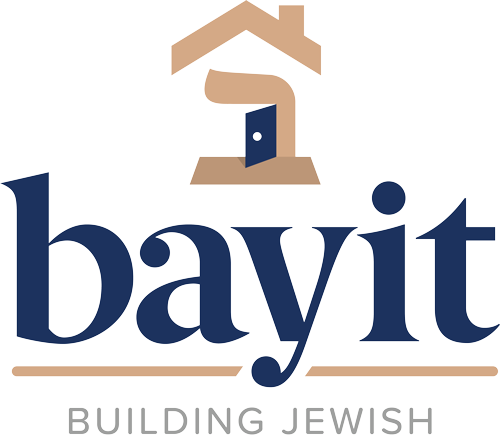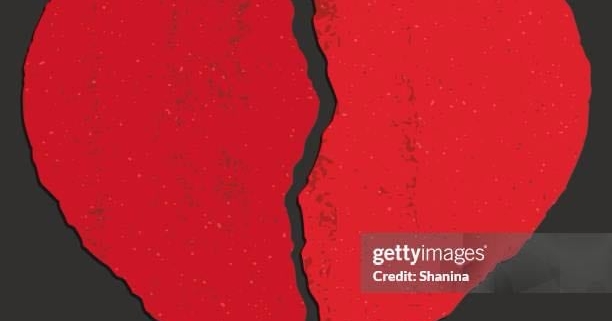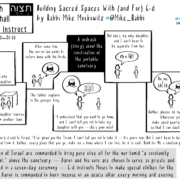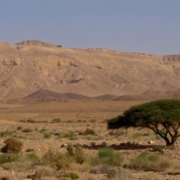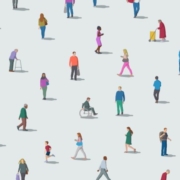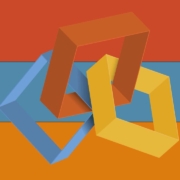Lifting Up
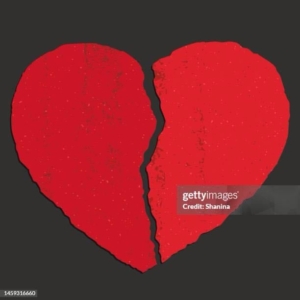 “There is nothing as whole as a broken heart.” This famous teaching from the Kotzker Rebbe is crucial to understand not only Yachatz, the fourth stage of the Seder, but the seder itself as a holistic intention. We often think that something breaks because it simply wasn’t strong enough to hold itself together. However, on the night of Passover1 we break the middle matzah2 in order to open ourselves up even more and strengthen our evolution towards perfection.
“There is nothing as whole as a broken heart.” This famous teaching from the Kotzker Rebbe is crucial to understand not only Yachatz, the fourth stage of the Seder, but the seder itself as a holistic intention. We often think that something breaks because it simply wasn’t strong enough to hold itself together. However, on the night of Passover1 we break the middle matzah2 in order to open ourselves up even more and strengthen our evolution towards perfection.
Known in the Seder as “Yachatz – יחץ,” this process involves halving the middle matzah which invariably produces two unequal parts. The smaller piece of the matzah is returned to its place for the telling of the story of our Exodus: “This is the bread of affliction that our ancestors ate in the land of Egypt.” Meanwhile, the larger piece is wrapped up and saved as the afikomen for tzafun, at the end of the meal.
The matzah, like all aspects of the seder, holds multiple and ostensibly contradictory identities. It is both the bread of liberation and enslavement. The Torah instructs us during Passover to eat “לֶ֣חֶם עֹ֑נִי – lechem oni,” the bread of poverty3 On a simple level, this means every Seder celebrant eats their matzah as if they were suffering from food insecurity, not only those who are actually in that state. So we eat the matzah as if we were hungry with no likelihood of later satiety, eating from the smaller portion, in order to save the rest for later.4
Paradoxically, the impoverished mixture of just flour and water is actually teeming with a wealth of meaning. The Talmud5understands the same words of the verse to mean “לֶחֶם שֶׁעוֹנִין עָלָיו דְּבָרִים הַרְבֵּה – the bread, about which we have many [celebratory]6 things to say.” By breaking the matzah, we open up the conversation known as maggid, to lean into the harsh injustices of our historical oppression and so better whet our appetite for the taste of freedom. Additionally, the word “עוֹנִין – onin” means “to answer,” and provides the structure of how to talk about the wisdom of liberation; through questions and answers.
On a deeper level, “לֶ֣חֶם עֹ֑נִי – lechem oni,” and the process of breaking that which is perceived as whole to restore the world to the way it should be, becomes the vision that we pray to actualize. Read this way, “לֶ֣חֶם עֹ֑נִי – lechem oni” means the bread that represents the answers to our prayers.7
Tradition teaches that the three8 matzot correspond, among many other things, to the three Patriarchs and their accompanying attributes: Abraham/chesed/kindness, Isaac/gevurah/strength, and Jacob/tiferet/splendor.9 The middle matzah therefore represents Isaac, who has many connections to the redemption associated with Passover, including it being the time he bestowed the blessings of the firstborn to Jacob.10 It is therefore not coincidental that “לֶ֣חֶם עֹ֑נִי – lechem oni” shares the same numerical value with “Isaac – יצחק.”11
It is from Isaac’s birth that the 400 years of being enslaved are counted, as opposed to the 210 years that the Israelites were physically slaves in Egypt.12 We also find that it is Isaac who uniquely responds to God on the Israelites’ behalf,13 and his commitment to them is marked in scripture through a fascinating alternative spelling of his name.
Isaac’s name, יִצְחָ֑ק, is given by God14 and is inspired by the word for laughter.15 This world, in its current state of brokenness does not offer us complete joy or happiness. Therefor true, total laughter is framed in future tense: “אָ֤ז יִמָּלֵ֪א שְׂח֡וֹק פִּינוּ֮ – then our mouths with be filled with laughter16 It is perhaps for that reason that Psalm 105, which focuses our praise to God on our ancestral covenant, references the oath that was given to Isaac as “וּשְׁב֖וּעָת֣וֹ לְיִשְׂחָֽק,” with a “shin – ש” not the usual “tzadik – צ.”17 The difference between the value of “shin – ש,” which is 300 and “tzadik – צ,” which is 90, is 210 – the number of actual years spent enslaved in Egypt.
This is significant because, like the middle matzah that holds multiple allusions, these letters signify that the only way to achieve a healed future18 is to feel and elevate the brokenness of the moment. This is one of the intentions we are meant to bring when we literally raise up the seder plate to name and examine the matzah, in all of its brokenness.
The “tzadik – צ” in Isaac’s name, יִצְחָ֑ק, is also in allusion to the strength that it takes for us to be righteous, a tzadik, and create communities of justice.19 Isaiah prophesies:
“מִכְּנַ֨ף הָאָ֜רֶץ זְמִרֹ֤ת שָׁמַ֙עְנוּ֙ צְבִ֣י לַצַּדִּ֔יק –
From the edges of the earth we have heard songs, “glory for the righteous.”20
In the mystical tradition, this verse is referring to the liberation of four out of the five letters that are known as the “doubles,” those that are written differently when they appear at the end of a word: מנצפ“כ.21 Beginning the verse with four of the five letters introduces the “doubling” of the fifth, “tzadik – צ,” later in the verse: “צְבִ֣י לַצַּדִּ֔יק – glory for the righteous.”
For the righteous, the daily struggle is such a preoccupation that the ultimate “light” is planted for the future: אור זרע לצדיק.22 On the night of Passover, we elevate and center the brokenness. It is only through moral clarity that we can move out of the darkness into the light of redemption.
1. [The numerical value of “Passover” is the same as “broken” חג המצות = נשבר.
]↩
2. [Corresponding to the heart.]↩
3. [ Deuteronomy 16:3]↩
4. [The Rabbis also see being hungry as a prerequisite to fulfilling the mitzvah of eating matzah.]↩
5. [Pesachim 115b.]↩
6. [Chidushei Chasam Sofer “היינו דברי חירות.”]↩
7. [Vayikra Rabbah “תפלה עושה מחצה.”]↩
8. [There are actually 4 matzahs, once we break the middle one, in line with many other fours in the Haggadah.]↩
9. [See Gevurat Hashem 54:193 and notes for Rabbi Hartman.]↩
10. [The custom to “steal” the afikomen, according to some, is sourced in the subterfuge of that ordeal במרמה = אפיקומן.]↩
11. [208]↩
12. [See Pirk3i D’Rebbe Eliezer 48.]↩
13. [See Isaiah 63:16 and Tosphot HaRosh in Shemot]↩
14. [Genesis 17:19.]↩
15. [Rashi]↩
16. [Psalm 126:2.]↩
17. [Verse 9.]↩
18. [The smaller matzah represents this world and the larger the World to Come. See Rav Schwab]↩
19. [See Ari Z”L on VaYehi Noam.]↩
20. [ Isaiah 24:16.]↩
21. [See Zera Kodesh on Haftorah of Vaetchanan]↩
22. [Psalms 97:11.]↩

Rabbi Mike Moskowitz is a founding builder at Bayit, author of several books, and scholar-in-residence for queer and trans Jewish studies at Congregation Beit Simchat Torah.
